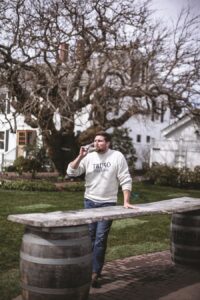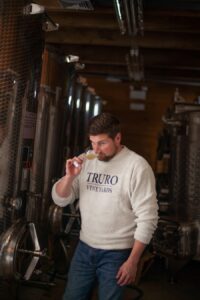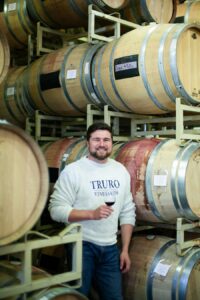TRURO — I’m not sure what to expect as I pull into Truro Vineyards to meet the new senior winemaker, briefed by an online industry publication’s profile that called him a “heartthrob” with a passion for wine “as hot as his hairstyle.” When he emerges from between the winery’s stainless-steel tanks, his hair looks fine, but it’s Jacques van der Vyver’s high-wattage smile that gets my attention.
Van der Vyver moves to turn down the rock anthems blaring from the winery speakers, then grabs my hand, shaking it in a friendly greeting like a cheerful Bacchus in a button-down. His accent gives away his off-Cape origins. He’s come to Truro from the Western Cape of South Africa, stopping for successful stints as a winemaker in Maryland and Connecticut on the way.

When he was young, van der Vyver traveled to his country’s top wineries with his father, a mechanical engineer involved in renovating wineries’ infrastructures. What he wanted to learn about most, though, was grape-growing and winemaking.
The University of Stellenbosch, in one of South Africa’s most famous wine-producing regions and where van der Vyver got a degree in agriculture and cellar and vineyard management, is something like “the U.C. Davis of South Africa,” he says. Now he’s working toward a Level 4 diploma from the Wine and Spirit Education Trust, an expert-level step that would allow him to sit for the Institute of Masters of Wine exam. Since the inaugural exam in 1953, only 500 people have been admitted to the prestigious circle of Masters of Wine worldwide.
South Africa’s vineyards are mainly located in the Western Cape, but they stretch across varied microclimates, from warm, dry inland areas to mountain slopes to the humid coasts. Van der Vyver is interested in the challenges and possibilities that range represents for winemakers. When he moved to the U.S. 10 years ago — partly motivated by the desire to leave behind the social and political struggles that still plague his homeland but even more by the desire for new winemaking challenges — he resisted the pull of California to take a less-traveled road.
He was working at Haight-Brown Vineyard in Litchfield, Conn. when he met Lauren Mahaney, whose family had spent summers in Orleans since the 1950s. The two were married in 2015. When he heard about the vintner job at Truro Vineyards, the Outer Cape did not seem like too big a detour. He became their head winemaker in March.
The East Coast, van der Vyver points out, is a historic winemaking region stretching from the Finger Lakes of New York to the Haw River Valley of North Carolina. One of the earliest agricultural efforts of European colonialists in North America was the planting of vineyards. “East Coast wine is still developing,” he says, “and being part of that is exciting.”

Still, he admits, “The humidity of the East Coast does make viniculture challenging.” The thing to do, he says, is to try to work with the climate rather than against it. “You can’t make a California-style wine here,” he says. “And why would you want to?”
While Truro Vineyards has about three acres of grapes under cultivation, most of the fruit used by the winery is brought in from other vineyards in the form of juice for white wines and whole fruit for reds. Grape sourcing is not an unusual practice for small wineries, says van der Vyver. To keep the wine regionally rooted, he buys exclusively from East Coast vineyards.
The Outer Cape’s cooler summers and shorter growing seasons mean that some of the vineyard’s greatest successes have been with whites, especially sauvignon blancs, albariños, and the vineyard’s white blend (a combination of albariño, pinot blanc, and Riesling). It happens, says van der Vyver, that these wines go well with our seafood-focused cuisine.
On a walk through the winery, van der Vyver offers a mini-lesson in one of the most significant aspects of the winemaking process, the selection of oak barrels for aging. Part of his role is to experiment with barrel types to create specific characteristics. East Coast reds like Truro Vineyard’s Maritime Red or Cabernet Franc “should be fresh and fruity,” he says, “so for them we choose barrels that will not overburden the wine — generally French and Hungarian oak barrels play a supportive role. Barrel production is one of the most enjoyable parts of winemaking,” he adds. “It’s pure art.”

The barrels cost about $1,200 each and have a life of about four years, van der Vyver says. As a result, he puts his cellar management skills into play in pursuit of thoughtful economies. After they’re used for aging wine, the barrels are repurposed for Madeira — a fortified wine — and after that they’re transferred to the distillery for aging bourbon.
Now that he’s settled in, or partly so (he and Lauren and their two-year-old daughter, Vonnie, are living in Eastham but still looking for a year-round place), van der Vyver is turning his attention to other experiments.
Among them, he says, is an exploration of native ferments, using indigenous yeasts from the vineyard to catalyze a wine’s primary fermentation — one more step, he says, in making wine that draws its specialness from place.



